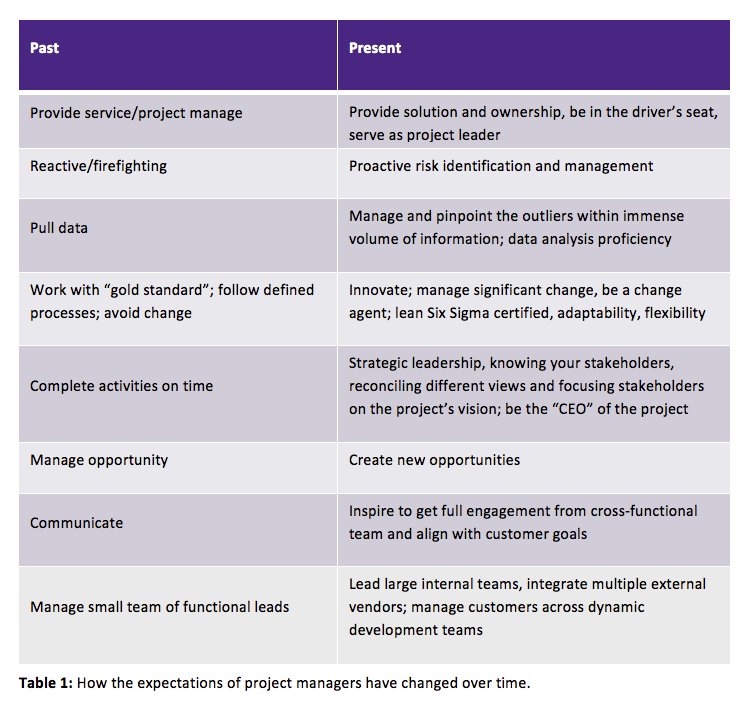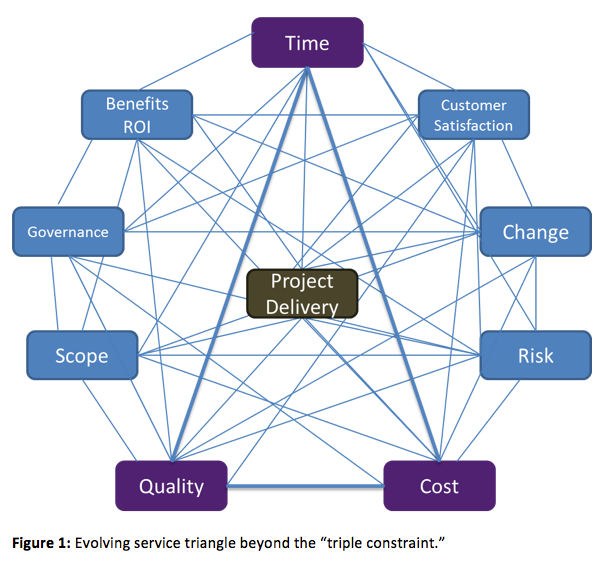The Changing Role of the CRO and its Effect on Project Management
Market trends are driving the need for biopharma to decrease fixed costs, leading to increased outsourcing to CROs. To meet greater demand, the role and profile of Project Managers needs to continuously adapt to an ever changing clinical trial environment.
Market trends are driving the need for the biopharmaceutical industry to decrease fixed costs, which leads to increased outsourcing to contract research organizations (CROs).1 CROs have reacted by forming multiple strategic alliances with the largest biopharma companies, but also by adopting their project management operating models to meet the unique needs of big pharma, as well as those of the smaller biotech or virtual organizations. In addition, CROs have invested a lot in data analytics systems and project management technologies or acquired companies to complement their service portfolio to ensure they fully realize the opportunity and are able to offer sponsors end-to-end services.
In parallel, clinical trials have become more complex. A few facts are driving this trend. The number of protocol procedures increased by 57% from 2000 to 2011.2 Enrollment of patients is becoming more difficult, with a decrease in enrollment rate of 18% between 2002 and 2011, which has led to an increase in the number of trial sites by 58%.3 Regulatory agencies are requiring more data, especially on long-term safety or special patient populations. Payers demand more information on how drugs/biologics perform relative to products already on the market, which introduces further price pressure. Personalized medicine, companion diagnostics, adaptive design and mobile health are emerging trends that will continue to grow and add further trial complexity.1Impact to project management
This increased complexity places greater strategic demands on CROs and project managers (PMs).4 To ensure operational excellence and financial profitability under an ever-changing and challenging clinical trial environment, the role and profile of the PM needs to continuously evolve5 beyond the management of the “triple constraint.” The competencies of the PM in the past are not those required for today (see Table 1).

In the past, PMs adhered to a simplistic but still established service triangle of time, cost and quality (i.e., triple constraint). But today that model has evolved significantly and PMs really need to sit in the driver’s seat, be fully accountable, push innovation, provide strategic leadership and drive more thorough risk analysis and management, ultimately ensuring return of R&D investments and delivery of perceived customer value (see Figure 1).

This evolution has had significant impact on PMs. For example, PMs need to think beyond simple risk management practices, ensuring high-level quality and navigating the more demanding risk strategy described ahead while, at the same time, driving customer satisfaction and ROI.
With TransCelerate BioPharma Inc. and regulatory authorities driving toward more quality throughout the design, conduct, recording, evaluation, reporting and archiving of clinical trials, risk assessment and management clearly will be a more and more critical part of successful project management.3 PMs need not only to understand the operational risks (e.g., enrollment of subjects) of a clinical study, but need to identify those study processes and data that are critical to ensure human subject protection and the reliability of study results. PMs need to focus on key risk indicators (KRI), which are critical predictors of unfavorable events that can adversely impact clinical studies and to detect trends early. According to the draft revision of the ICH E6 guideline, risks should be considered at the system level (e.g., facilities, standard operating procedures, computerized systems, personnel and vendors) and clinical trial level (e.g., investigational product, trial design, data collection and recording).
In the past, PMs “only” had to manage their assigned projects because the outsourcing model was largely transactional. PMs were assigned in order to fulfill requests from clients. But now, as CROs have developed strategic relationships with some of the largest biopharma companies, PMs need to think ahead to see the bigger picture of the drug development plan and create new opportunities for the CRO and its clients.3 PMs must look at the entire lifecycle of a study-and beyond-to find opportunities to reduce cost and speed up timelines, while ensuring the highest possible quality.
Traditionally, PMs spent much of their time looking for information. However, with the implementation of sophisticated data analytics tools, this data is now available at their fingertips. PMs need to get their arms around them and provide data analysis proficiency, turning data into information in order to enable faster decision-making and proactive identification of trends and emerging risks.
Managing yourself and your team
PMs used to work with “gold standards,” but now need to be flexible and open to constant change, while always striving for better solutions. CROs are not only looking for project management-certified PMs (e.g., Project Management Institute), but also for PMs who are proficient in process improvement methodologies like lean Six Sigma to identify areas of waste in processes and projects.6 As PMs become more adaptable, they also need to overcome resistance to change in team members by leveraging their project management skills. Hence, pure project management skills, like planning and analysis, will need to be combined with change management abilities in order to achieve project success.
Good communication always has been a core behavior for PMs in order to effectively collaborate with individuals at all levels.2 Today, however, PMs need to inspire a shared vision and empower their teams to achieve full engagement.
PMs also need to be able to see the “big picture,” be fully aligned with their customer’s goals and objectives and understand how their decisions may significantly impact the customer’s overall development plan. This will help them to successfully manage scope, risks and their project team.
In the past, there was an emphasis on the technical components of project management (e.g., developing a project plan, using scheduling software, etc.). Today, there is a much broader emphasis on softer skills (e.g., leadership, negotiation skills, etc.), the team dynamic components and the relationship pieces, which are really critical for the success of any PM.5
As projects became more complex, the size of the teams also has increased. For the PM, this means a larger team of specialists to manage, more departments and vendors to coordinate and more stakeholders to be accountable to.
More often, PMs may be working remotely from a home-based location or certainly in a location that isn’t comprised of the entire team. PMs need to be able to leverage their communication and other soft skills to effectively manage a globally diverse team. PMs will need to be good self-managers in addition to possessing the ability to successfully facilitate conditions, a trait that encourages team interaction and connection.
As illustrated in Table 1, a successful PM today and in the future will need to be able to balance the hard and soft skills while having the ability to process complex information and embrace change.
The path forward
To maximize return on R&D investments, strengthen market position and maximize efficiencies, CROs and their PMs should be involved as early as possible in the product lifecycle management to align expectations and fully understand the goals and objectives of their client’s development plan. In addition, PMs will need to use leading-edge technologies like risk-based monitoring and data analytic platforms. And they will need to continuously improve standard processes and establish other innovative approaches to bring business value, realize cost reductions and ensure shorter development cycles.
Clearly, a lot of change is ongoing in the biopharma industry that is driving CROs to become more innovative. That has had a significant impact on project management and the evolution of the PM profile. Managing increased complexity while taking on more project leadership continues to be a top priority for PMs. Not only do they need to embrace it, they need to help their teams embrace it. This will ensure CROs stay at the forefront of innovation-to bend the cost and time curve of drug discovery and development and, thus, enabling clients to get life-changing therapies to patients faster with higher return on their R&D investments.
Volker Hack is Senior Director and Head of Project Management Standards Group, PPD; Denise Sackner is Director, Project Management Standards Group, PPDReferences
- CRO Outlook & Drug Development Trends, Contract Pharma, May 2015, Kristin Brooks, 1-5.
- Getz et al. “Variability in Protocol Design Complexity by Phase and Therapeutic Area.” Drug Information Journal, 2011 45(4); 413-420.
- Why Are Cancer Clinical Trials Increasing in Duration? Aug 31, 2015, By Moe Alsumidaie, Peter Schiemann, PhD, Applied Clinical Trials, http://www.appliedclinicaltrialsonline.com/why-are-cancer-clinical-trials-increasing-duration.
- The Changing Role of Project Managers, http://www.appliedclinicaltrialsonline.com/changing-role-project-managers, Applied Clinical Trials, November 2008.
- The Evolving Role of the Clinical Project Manager, PharmaVOICE - April 2007, Denise Myshko, http://www.pharmavoice.com/article/2007-04-the-evolving-role-of-the-clinical-project-manager.
- Five Lightweight Techniques for Improving Your Business Processes, Contract Pharma, September 2015, 17 (7) 88-94, Volker Hack, Laura Bowers.
Unifying Industry to Better Understand GCP Guidance
May 7th 2025In this episode of the Applied Clinical Trials Podcast, David Nickerson, head of clinical quality management at EMD Serono; and Arlene Lee, director of product management, data quality & risk management solutions at Medidata, discuss the newest ICH E6(R3) GCP guidelines as well as how TransCelerate and ACRO have partnered to help stakeholders better acclimate to these guidelines.
Phase III PROMINENT Trial Initiated to Evaluate Felzartamab for Primary Membranous Nephropathy
June 30th 2025The global Phase III PROMINENT trial has begun dosing patients to evaluate felzartamab in treating primary membranous nephropathy, a serious autoimmune kidney disorder with no FDA-approved therapies.
Funding Cuts Threaten Diversity in Clinical Research
June 27th 2025In this video interview, Kyle McAllister, co-founder, CEO, Trially, discusses how recent federal funding cuts are likely to undermine research focused on underrepresented populations, and why long-term investment in community-based studies is essential to closing persistent health equity gaps.